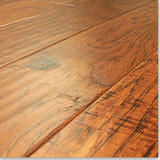
When remodeling, many homeowners want hardwood flooring. Solid hardwood floor is difficult to install on your own– you almost always need to hire hardwood floor installers for this– and can be finicky when it comes to moisture. And laminate flooring, as much as it looks like actual wood flooring, simply is not real wood.
Engineered Wood Flooring is Real Wood.
Laminate is melamine-infused paper on top, wood chip composite on bottom. Not exactly what you would call real wood. Solid hardwood is real wood, from top to bottom. Engineered wood, too, is real wood. It is a sandwich of 1/16″ to 1/8″ of finish wood on non-finish and top plywood underneath. What you’re looking at is 100 % genuine wood.
But did you know that it’s actually better to have plywood underneath? That’s right: the middle layer of plywood is laid cross-ways to the finish layer, providing additional strength to the flooring.
Engineered Flooring Species Options.
Whatever specie of solid hardwood, there is an equivalent specie of engineered wood flooring. From our Engineered Floor Buyer’s Guide, here are just a few:
- Hickory – Rich, hand-scraped hickory gives your house a timeless feeling.
- Oak – Traditional red oak is inexpensive and always looks great.
- Bamboo – Bamboo engineered flooring? Well, all bamboo flooring is engineered. Bamboo flooring is cheap and “green”.
- Maple – Maple is an elegant finish, appropriate for dining, family, and living rooms.
Engineered Wood Floor is Pre-Finished.
The top finish layer is pre-finished, which means that it’s already sanded and sealed. As soon as the floor has been laid, you can walk on it. By contrast, unfinished solid hardwood must be sealed, and this requires waiting time before use. Note: solid hardwood is available pre-finished, as well.
Engineered Wood Flooring Can Be Sanded.
The advantage of engineered wood flooring versus laminate is that engineered wood can be sanded after dings and scratches develop. Two catches:
- Limited Sanding – Engineered flooring can not be sanded more than 1-3 times (depending on the thickness of the finish layer).
- Professional Sanding Recommended – Because of the low tolerance for failure with sanding engineered wood, I seriously recommend that you have a professional do the sanding. It is very easy to gouge your engineered wood floor, revealing the plywood underneath.
What About Areas With Light Moisture?
Engineered wood flooring works well in basements, bathrooms, and kitchens where light moisture might be present. Still, it doesn’t hold up to really wet areas such as basements that flood frequently. Nor does it hold up to kids’ bathrooms which, as you may know, tend to flood frequently. Truthfully, no wood flooring product is great for very wet areas (tile, concrete, vinyl, or any other non-organic product is best). Relative to other wood flooring products, engineered wood isn’t bad.
A Range of Installation Methods.
Unlike solid wood, which must be nailed to a wood sub-floor, engineered wood can be installed in a different number of ways. Depending on the type you buy, it can be either:
- Nail-Down Floor. This is for the 3/8″ thick floor– its thinness requires nailing to enhance stability;
- Glue-Down Floor. The 1/2″ thick floor can be nailed down; or
- Floating Floor. The 5/8″ planks are thick enough to act as a floating floor.
And laminate flooring, as much as it looks like actual wood flooring, simply is not real wood. Not exactly what you would call real wood. Solid hardwood is real wood, from top to bottom.
Engineered wood, too, is real wood. Engineered wood flooring works well in basements, kitchens, and bathrooms where light moisture might be present.
